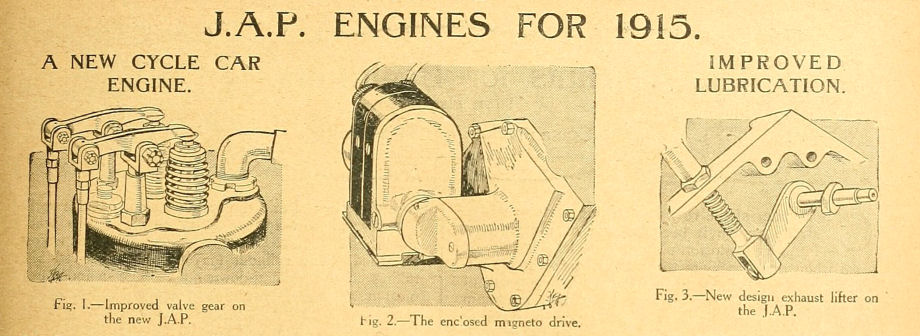



A NEW CYCLE CAR ENGINE. IMPROVED LUBRICATION.
THE firm of Messrs. J. A. Prestwich and Co. was one of the first businesses to take up the manufacture of motor cycle engines in this country and to tackle seriously the foreign competition which was prevalent in the early days of the movement. Since that time the firm has gone ahead to a wonderful extent, and the large works recently taken over have been already considerably extended.
The latest production is an 8 h.p. cycle car engine of 1,082 c.c, the bore and stroke of which respectively are 90 mm. x 85 mm. It will be noticed on referring to the accompanying photograph that the crank case is an exceptionally large one. This allows large inside flywheels and does away with the necessity of a heavy clutch flywheel, and this, it is claimed, results in a much better balance. Moreover, the large crank case allows of very much bigger bearings, which have been increased in area 100%.
Other improvements are shown in detail; fig. 2 is the carefully enclosed magneto drive, and the interior mechanism of the exhaust valve lifter is shown in fig. 3. Instead of the rack and pinion system employed on last year's models there is now a spindle on which there is a double-face cam. a crank being connected directly to the spindle to which the Bowden wire is attached. The double-face cam works between the two tappet rockers, and is simple and well designed.
Considerable interest is to be attached to the valves, the design of which has been carefully studied. In the valves themselves particular attention has been paid to the question of heating, and they are designed so that the heat is conducted away from the mushroom on to the stem as soon as possible, and, as will be seen in fig. I, the amount of stem exposed to the air is considerable. A great improvement has been made in the manner in which the spring cup is attached to the stem, and no cotter is utilised. The forks supporting the overhead rockers are screwed into the cylinder head, and are further secured by means of long nuts clearly shown in the illustration. These act as lock nuts and also as supports to the fork stems. The valve ports are all streamline in shape, and the general design of the engine has been given the special attention of Mr. E. B. Ware, an expert motor cyclist whose scientific abilities are not so well known as they deserve to be, and whose aim has been to bring out an engine in which the principal features are smooth, steady running and flexibility.
The excellent J.A.P. system of lubrication has been improved. This system, we may reiterate, consists of utilising the crank case compression and destroying the crank case suction by means of a valve. By its means quite a powerful jet of oil is forced through, the valve, and the lubricant first issues through the main bearing, part of it passing through a hole in the bearing and part going behind the bush, issuing from a nick between the aluminium and bronze and being carried round to the crank pin and thence to the big end, while another portion of it goes through a pipe to the front cylinder, and yet another pipe conveys the oil to the plain bearing on the "pulley" side of the crank case. This idea of lubricating the front cylinder will be incorporated in all J.A.P. models next year.
The engine, it will be noticed from the accompanying photograph, is fitted to a Morgan chassis which Mr. Ware has got out for his own use on the track. It has been considerably improved in design : for example, the oil and petrol pipes, instead of passing outside the bonnet, come straight under the chassis directly to the carburetter and crank case. The bonnet side has been filled in.
The J.A.P. Works for 1915 will produce the following engines: the 2 ½ h.p. and 4 h.p. single and the 4 h.p., 5 h.p., and 6 h.p. twins, and the cycle car engine just described.
The Motor Cycle, October 22nd, 1914. p461